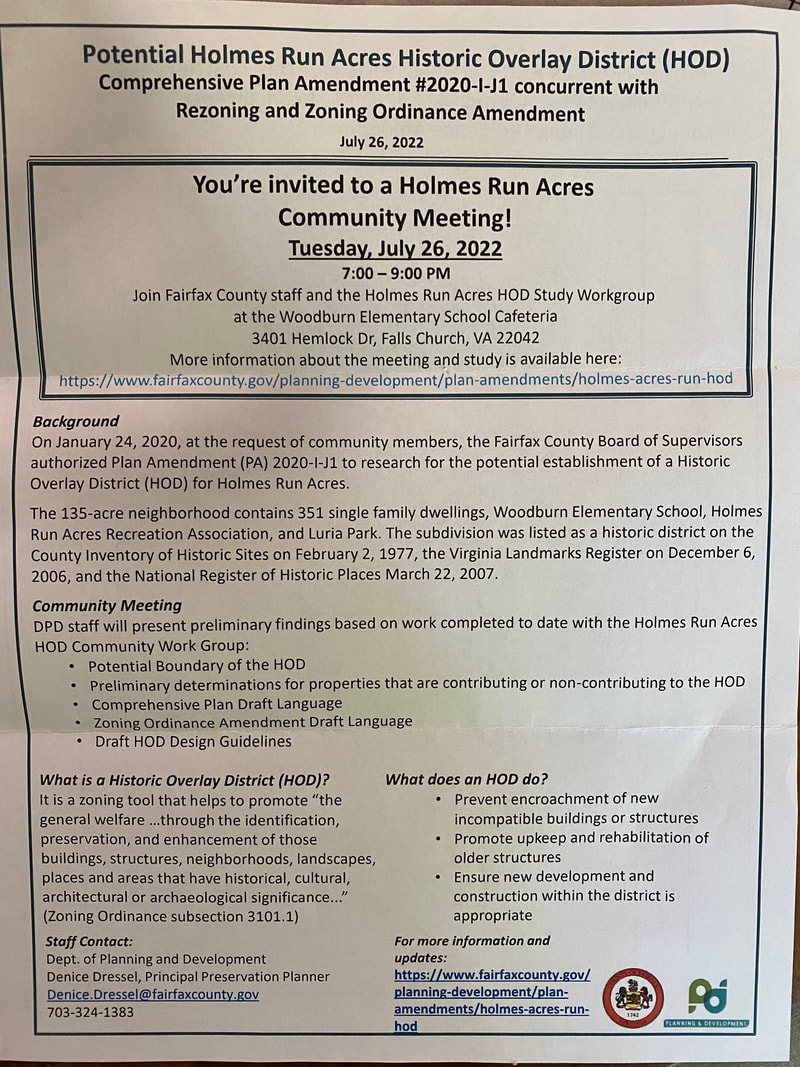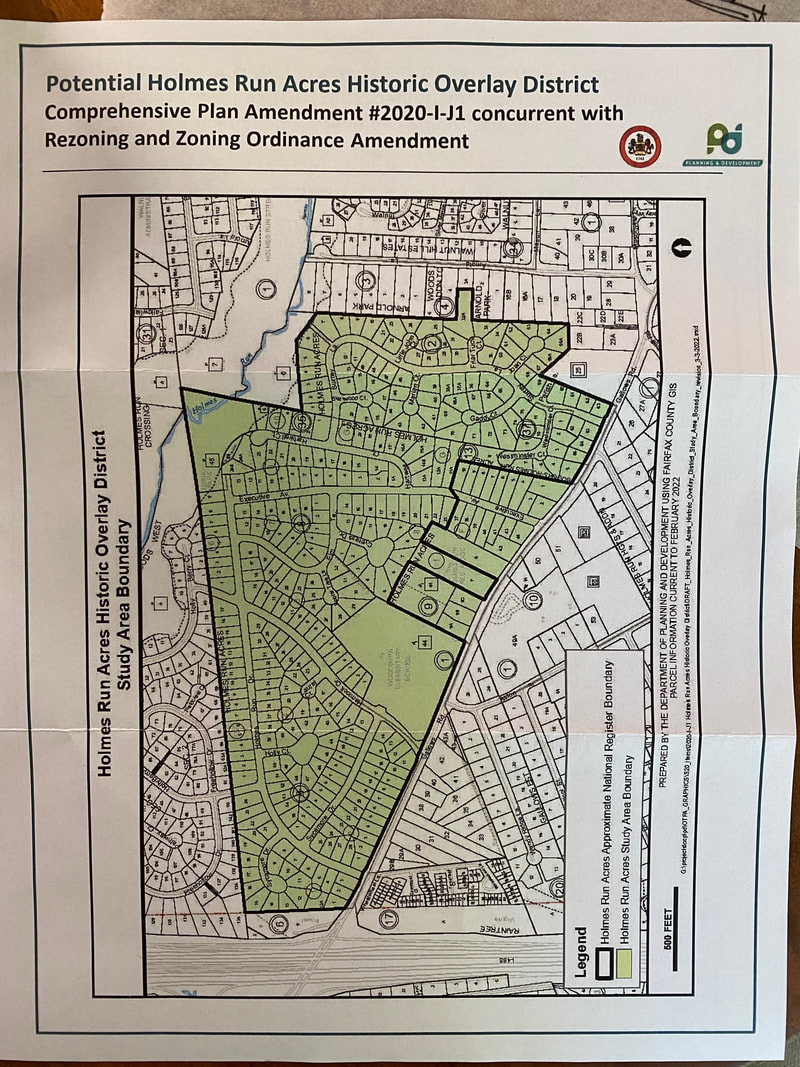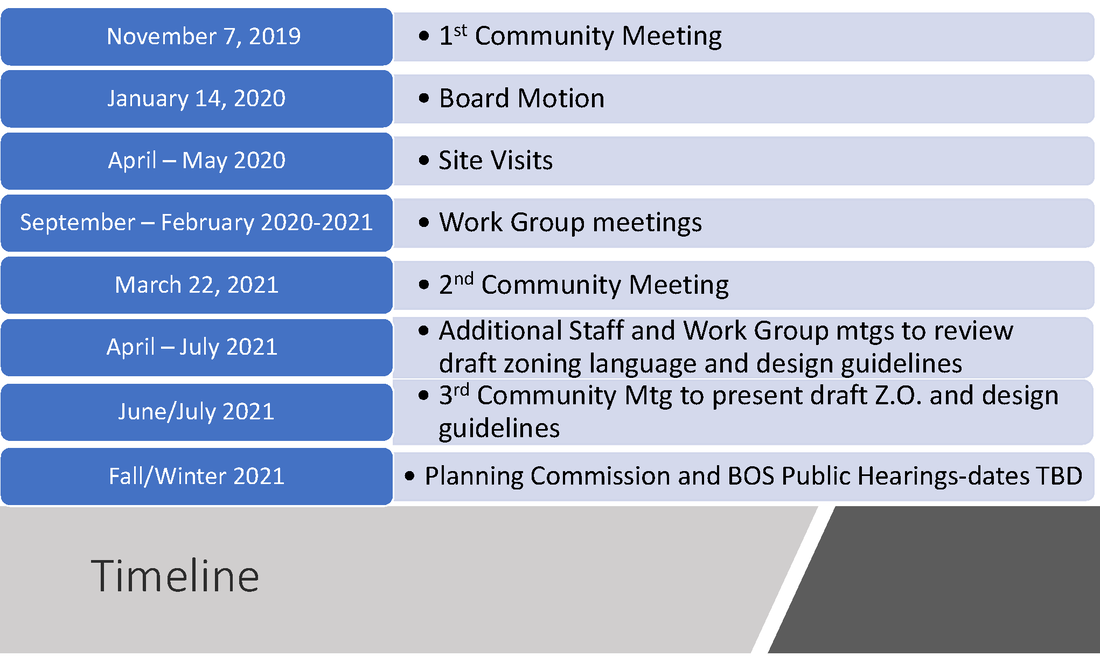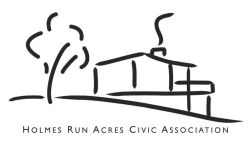Pursuing a Historic Overlay District for Holmes Run Acres
HRA neighborhood historic overlay district poll closes Friday, September 9
The poll, and information about the proposed HOD package, can be accessed at https://publicinput.com/ffx-hra-hod
The poll, and information about the proposed HOD package, can be accessed at https://publicinput.com/ffx-hra-hod
Update, 7/12/2022
Dear Neighbors,
The above invitation arrived in my snail mail today. You should be getting yours shortly if you haven’t already received it. The invitation is packed with information and links. Please take some time to read and familiarize yourself with the proposed Historic Overlay District (HOD) for HRA before the community meeting on Tuesday, July 26 from 7-9PM in the Woodburn Cafeteria. If you have questions, please reach out to the staff contact listed on the invitation. You can always reach out to me directly, too, and I will try to help. The more questions the county receives ahead of the meeting, the more prepared they can be with answers for us at the Community Meeting.
A couple of things that bear repeating as you familiarize yourself with an HOD (Historic Overlay District):
Many thanks for your interest, and for reading this far.
Edith
Chair, FoHRA and HOD effort.
Past President, HRACA
The above invitation arrived in my snail mail today. You should be getting yours shortly if you haven’t already received it. The invitation is packed with information and links. Please take some time to read and familiarize yourself with the proposed Historic Overlay District (HOD) for HRA before the community meeting on Tuesday, July 26 from 7-9PM in the Woodburn Cafeteria. If you have questions, please reach out to the staff contact listed on the invitation. You can always reach out to me directly, too, and I will try to help. The more questions the county receives ahead of the meeting, the more prepared they can be with answers for us at the Community Meeting.
A couple of things that bear repeating as you familiarize yourself with an HOD (Historic Overlay District):
- Understanding Building Permits:
- If your project does not require a Building Permit now it won't require one under an HOD. If your project does require a Building Permit now then it will be the same process under an HOD with one exception: under an HOD, your application will have an additional review, by the County Architectural Review Board (ARB). In other words, only those projects that currently require a Building Permit will be subject to the additional review by the ARB, under an HOD.
- Understanding the ARB (Architectural Review Board):
- The county ARB will review applications for Building Permit against the Design Guidelines
- The HRA Design Guidelines are guidelines specific to HRA and its history. They are not generic ‘historic guidelines’.
- The HRA Design Guildelines are advisory guidance, and not a checklist of zoning ordinance requirements.
- The ARB has significant discretion
- The ARB has already exercised deference to the needs of Hollin Hills applicants
- Hollin Hills is another Mid Century Modern neighborhood that just got HOD designation
- you can link to Hollin Hills ARB reviews, which are public and recorded, on the County website. You can reach out to the staff contact if you’re having trouble finding the link.
- You can ask to meet with the ARB ahead of filing for a Building Permit application, for an interpretation of the Guidelines vis-a-vis your specific project.
- New Materials come along all the time and many make sense to use (e.g. Frank Lloyd Wright would’ve loved “low-E” - low emissivity - glazing, and would’ve use it; roofs don’t have to be tar and gravel…though I can attest to how lovely they sound in the rain). The HOD does not wish to recreate the 1950s but rather to keep the character of the neighborhood, the tenets of its mid-century architecture, foremost of which is its connection to nature.
- The county ARB will review applications for Building Permit against the Design Guidelines
- Understanding HRA:
- our houses were built as starter homes of modest scale. They were designed to be added onto, and many houses have done so successfully, in a manner that retains the character of the neighborhood while being specific to its homeowner’s wishes. Our specific HRA HOD takes this into consideration.
- Understanding an HOD:
- An HOD is a tool that few neighborhoods can avail themselves of (because they don’t have the historic significance of an HRA). The purpose of an HOD for HRA is to to help us steward our neighborhood of significant American architecture, albeit with humble beginnings.
- The purpose of an HOD is not to punish the homeowner! Rather, the purpose of an HOD is to put the pause button on tear downs, to help us all understand the significance of what we have and why we should honor it in our renovations and additions. And to do so while allowing us to still modernize our homes and retain their value.
Many thanks for your interest, and for reading this far.
Edith
Chair, FoHRA and HOD effort.
Past President, HRACA
Update, 2/17/2022
HOD = Historic Overlay District
I urge all neighbors who live in the Acres to read up on the HOD, ask constructive questions, make constructive comments:
Moving forward, here is a rough timeline:
HOD = Historic Overlay District
I urge all neighbors who live in the Acres to read up on the HOD, ask constructive questions, make constructive comments:
- You can read up on the history of it within the Acres, on our website holmesrunacres.com. You can read up on it as a matter of public record with the County at fairfaxcounty.gov, search, “HRA HOD”.
- You can ask questions directly to Denice Dressel (county heritage lead on this effort; her contact info is on our webpage under the HOD tab; it’s also available on the county website). You can also ask me, and I can forward your question to Denice if I cannot answer it.
Moving forward, here is a rough timeline:
- The next WorkGroup meeting is scheduled for March 16, 2022 at 6:30PM. The link for it will once again be posted on the County webpage.
- A Community Meeting is tentatively scheduled for this May. We hope this will be in-person. The focus of the meeting will be to bring the Community up to speed on this HOD effort/study, and to share the final Guidelines.
- There will be a Q&A portion of this Community Meeting.
- I urge folks to read up and send questions in advance. This will give the County an opportunity to address more questions from the community.
- If, at the end of the meeting, there are questions posed for which the County doesn’t yet have an answer, or we run out of time, the County has agreed to address these after the meeting in a timely fashion, prior to the ballot.
- There will be a Q&A portion of this Community Meeting.
- A ballot initiated by FoHRA and the WorkGroup, but administered by the County, will issued online and paper by request, to every parcel within the HOD boundaries. This ballot will be to vote yay/nay for the HOD (the vote we held back in the winter of 2019-2020 was yay/nay for a to pursue an HOD study only). This ballot is to gauge the Community’s interest to create an HOD for HRA.
Update, 11/9/2021
It has been a while since the workgroup met; a meeting is tentatively schedule for November 17th at 6:30. The County will post meeting details and the agenda closer to the date. Denice Dressel has taken over from Nicole Brannon for the County. She is a Senior Heritage Resources Planner with the Department of Planning and Development and will be working with us to complete the Holmes Run Acres HOD study. Her contact info is below.
Denice Dressel, MAHP
ARB Administrator/History Commission Liaison
Heritage Resources-DPD
O: (703) 324-1383
https://www.fairfaxcounty.gov/planning-development/historic
It has been a while since the workgroup met; a meeting is tentatively schedule for November 17th at 6:30. The County will post meeting details and the agenda closer to the date. Denice Dressel has taken over from Nicole Brannon for the County. She is a Senior Heritage Resources Planner with the Department of Planning and Development and will be working with us to complete the Holmes Run Acres HOD study. Her contact info is below.
Denice Dressel, MAHP
ARB Administrator/History Commission Liaison
Heritage Resources-DPD
O: (703) 324-1383
https://www.fairfaxcounty.gov/planning-development/historic
Update, 04/19/2021
On Monday, March 22, 2021 at 6:30PM, the Holmes Run Acres Historic Overlay District (HOD) Community Meeting was held virtually via WebEx. Nicole Brannan, Fairfax County Heritage Staff in charge of this project, reports that around 40 folks attended at the time of the WebEx meeting (plus Fairfax County staff. Supervisor Palchik also attended briefly), and 59 viewings have happened since the video was posted. The video is available online: search HRA HOD Community Meeting on fairfaxcounty.gov website.
At this time, Nicole is still preparing the Question and Answers from the Community Meeting, and we will post them here when she forwards them to us.
On Monday, March 22, 2021 at 6:30PM, the Holmes Run Acres Historic Overlay District (HOD) Community Meeting was held virtually via WebEx. Nicole Brannan, Fairfax County Heritage Staff in charge of this project, reports that around 40 folks attended at the time of the WebEx meeting (plus Fairfax County staff. Supervisor Palchik also attended briefly), and 59 viewings have happened since the video was posted. The video is available online: search HRA HOD Community Meeting on fairfaxcounty.gov website.
At this time, Nicole is still preparing the Question and Answers from the Community Meeting, and we will post them here when she forwards them to us.
Below are several documents that chart the main steps in this effort:
The process involved launching the inquiry - asking every household in the neighborhood (one vote per household) to vote yes or no via a survey - collecting a clear majority of “yes” votes in order to move forward (we collected 72% in favor), and asking our Providence Supervisor to make the motion to the Board of Supervisors to allow a study to begin, to assess the potential establishment of an HOD for our neighborhood.
Why did we decide to pursue this?
For years, there has been steady development pressure on our little neighborhood. The majority of us like our little area of peace inside the beltway, and prefer to hold onto it rather than see it flipped to larger homes that eat up the gardens and tree coverage on our lots, and replace these with bigger and taller, inward-focused, walls of structure. The larger home flips are especially egregious in a Mid-Century Modern neighborhood because the architecture of the MCM house - with its relatively low roof, large expanses of windows and its garden-like setting - depends on nature and view corridors for sense of space, and the houses are pleasant and inviting because of it. One of the enduring and beloved tenets of MCM architecture is its connection with nature. If we pave over this nature and disrupt our view sheds into this garden-like setting, if we instead look out of our windows at the wall of a neighbor’s McMansion, or into the windows of our neighbor whose house is now in close proximity, we will quickly seal up our glass to gain privacy, and our homes will feel tiny indeed. The character will change irreparably.
The majority of those fortunate to live in a MCM house usually arrive at the desire to protect them from those big builds. And this was exactly the sentiment expressed by a majority of our neighborhood after we lost a few of our homes to tear-downs and large builds that are completely out of character with our historic, MCM neighborhood. One could argue that this attitude is NIMBYism (Not In My Back Yard). But with the ever increasing spotlight on our utter dependence on nature for our health and well being, it is also the conscientious thing to do, to make every effort to save our trees and the ratio of ‘nature’ to ‘built structure’ in our little corner of this world. We now know, through scientific studies and reports, what common sense has told us for millennia: we are in a symbiotic relationship with trees and nature. They provide oxygen, they clean the air, they soak up water, they provide shelter for birds and animals that are beneficial to and part of the ecosystem, they provide shade from the heat of summer, and they lower our blood pressure. The list of nature’s benefits parallels that of trees. Once we chop the trees down and pave over our natural environment to put more building up, we lose our best friends in health. So it is more than just saving a few homes. It is a critical pushback to bad planning, with health as its underpinning.
We successfully fought several efforts to build multi-family homes across Gallows Road in what is zoned a Residential area. We had less successful impact on INOVA’s proposal to build out the old Exxon Mobil site (and bring with it attendant traffic that some have argued will amount to 50,000 trips per day more than we see now). Closer to home, we see that our homes in HRA are being courted by developers and would-be flippers. As mentioned above, two home sites have already fallen to this. We felt we had to do something.
An HOD will not prevent development around us, and it will not prevent tear-downs, but what it seeks to do is to put into a mandate, more modest renovations and additions that will allow us to maintain the nature and garden-like setting of our historic neighborhood for generations and years to come. Some see this as trying to stop progress. But is it progress when you ruin something good to make room for something else? Is it progress when you create built density in every single family residential neighborhood, at the expense of nature, landscape, habitat, trees, oxygen, and a peaceful quality of life? Perhaps an HOD can provide the gentle hand of reason, putting parameters in place to allow modernizing and progress while continuing to respect the garden-like setting that connects us currently, and while respecting one’s neighbor by staying sympathetic to modest scale.
The Fairfax County Board of Supervisors approved the HOD study in January of 2020. A group of 6 volunteers from HRA (a mixture of ‘for’, ‘against’, and ‘on the fence about’ an HOD) and Fairfax County Heritage staff are currently meeting monthly to flesh out the answer to, “what makes an HRA house?” Then, this same group will work with the County to come up with guidelines that, if adopted, would create the guidelines for the HOD for HRA.
The meetings are monthly. During the pandemic they are held via WebEx. The schedule and the link to listen to the meetings can be found here:
https://www.fairfaxcounty.gov/planning-development/plan-amendments/holmes-acres-run-hod
Many thanks to our Friends of Holmes Run Acres (FoHRA) committee, many thanks to the neighbors who helped FoHRA go door to door, and many thanks to our remarkable neighborhood for once again heeding the call when a critical matter was put before them.
Edith MacArthur,
Architect
Chair, Friends of Holmes Run Acres (a committee of the HRACA Board),
Past President, HRA Civic Association
- The flyer that launched the petition drive
- Meeting minutes from the November, 2019 Community Meeting at Woodburn Cafeteria
- Official motion made and approved at the Board of Supervisors meeting on January 14, 2020 by Providence Supervisor, Dalia Palchik
The process involved launching the inquiry - asking every household in the neighborhood (one vote per household) to vote yes or no via a survey - collecting a clear majority of “yes” votes in order to move forward (we collected 72% in favor), and asking our Providence Supervisor to make the motion to the Board of Supervisors to allow a study to begin, to assess the potential establishment of an HOD for our neighborhood.
Why did we decide to pursue this?
For years, there has been steady development pressure on our little neighborhood. The majority of us like our little area of peace inside the beltway, and prefer to hold onto it rather than see it flipped to larger homes that eat up the gardens and tree coverage on our lots, and replace these with bigger and taller, inward-focused, walls of structure. The larger home flips are especially egregious in a Mid-Century Modern neighborhood because the architecture of the MCM house - with its relatively low roof, large expanses of windows and its garden-like setting - depends on nature and view corridors for sense of space, and the houses are pleasant and inviting because of it. One of the enduring and beloved tenets of MCM architecture is its connection with nature. If we pave over this nature and disrupt our view sheds into this garden-like setting, if we instead look out of our windows at the wall of a neighbor’s McMansion, or into the windows of our neighbor whose house is now in close proximity, we will quickly seal up our glass to gain privacy, and our homes will feel tiny indeed. The character will change irreparably.
The majority of those fortunate to live in a MCM house usually arrive at the desire to protect them from those big builds. And this was exactly the sentiment expressed by a majority of our neighborhood after we lost a few of our homes to tear-downs and large builds that are completely out of character with our historic, MCM neighborhood. One could argue that this attitude is NIMBYism (Not In My Back Yard). But with the ever increasing spotlight on our utter dependence on nature for our health and well being, it is also the conscientious thing to do, to make every effort to save our trees and the ratio of ‘nature’ to ‘built structure’ in our little corner of this world. We now know, through scientific studies and reports, what common sense has told us for millennia: we are in a symbiotic relationship with trees and nature. They provide oxygen, they clean the air, they soak up water, they provide shelter for birds and animals that are beneficial to and part of the ecosystem, they provide shade from the heat of summer, and they lower our blood pressure. The list of nature’s benefits parallels that of trees. Once we chop the trees down and pave over our natural environment to put more building up, we lose our best friends in health. So it is more than just saving a few homes. It is a critical pushback to bad planning, with health as its underpinning.
We successfully fought several efforts to build multi-family homes across Gallows Road in what is zoned a Residential area. We had less successful impact on INOVA’s proposal to build out the old Exxon Mobil site (and bring with it attendant traffic that some have argued will amount to 50,000 trips per day more than we see now). Closer to home, we see that our homes in HRA are being courted by developers and would-be flippers. As mentioned above, two home sites have already fallen to this. We felt we had to do something.
An HOD will not prevent development around us, and it will not prevent tear-downs, but what it seeks to do is to put into a mandate, more modest renovations and additions that will allow us to maintain the nature and garden-like setting of our historic neighborhood for generations and years to come. Some see this as trying to stop progress. But is it progress when you ruin something good to make room for something else? Is it progress when you create built density in every single family residential neighborhood, at the expense of nature, landscape, habitat, trees, oxygen, and a peaceful quality of life? Perhaps an HOD can provide the gentle hand of reason, putting parameters in place to allow modernizing and progress while continuing to respect the garden-like setting that connects us currently, and while respecting one’s neighbor by staying sympathetic to modest scale.
The Fairfax County Board of Supervisors approved the HOD study in January of 2020. A group of 6 volunteers from HRA (a mixture of ‘for’, ‘against’, and ‘on the fence about’ an HOD) and Fairfax County Heritage staff are currently meeting monthly to flesh out the answer to, “what makes an HRA house?” Then, this same group will work with the County to come up with guidelines that, if adopted, would create the guidelines for the HOD for HRA.
The meetings are monthly. During the pandemic they are held via WebEx. The schedule and the link to listen to the meetings can be found here:
https://www.fairfaxcounty.gov/planning-development/plan-amendments/holmes-acres-run-hod
Many thanks to our Friends of Holmes Run Acres (FoHRA) committee, many thanks to the neighbors who helped FoHRA go door to door, and many thanks to our remarkable neighborhood for once again heeding the call when a critical matter was put before them.
Edith MacArthur,
Architect
Chair, Friends of Holmes Run Acres (a committee of the HRACA Board),
Past President, HRA Civic Association
archived documents
HISTORIC OVERLAY DISTRICT articles / links
- "Mid-Century Modern Revival: To Many Millennials, Frank Lloyd was Right" - Anne Pyburn Craig, October 8, 2019 - Chronogram
- "Millennials Don't Want to Buy Baby Boomers' Sprawling, Multi-Bedroom Homes, and It's Creating a Major Problem in the Real-estate Market" - Katie Warren, March 27, 2019 - Business Insider
- "Downsizing the American Dream: The New Trend Toward 'Missing Middle Housing'"- Haisten Willis, February 14, 2019 - Washington Post
- "Your House Is In A Historic District: Does That Raise Or Lower Its Value?" - Regina Cole, August 20, 2018 - Forbes
- "Hollin Hills Plan Amendment 2018-IV-MV4" - July 31, 2018 - Fairfax County
- "10 Benefits of Establishing a Local Historic District" - Julia Rocchi, December 8, 2015 - National Trust for Historic Preservation



